Analyzing NPP Response of Different Rangeland Types to Climatic Parameters over Mongolia
Abstract
:1. Introduction
2. Materials and Methods
2.1. Study Area
2.2. Data Processing Method
2.2.1. NPP Estimation from BEPS Model
2.2.2. Validation Analysis
2.2.3. Trend Analysis
2.2.4. Statistical and Correlation Analysis
2.3. Data Acquisition and Preparation
2.3.1. LAI Data
2.3.2. Climate Data
2.3.3. Land Cover and Tree Cover Data
2.3.4. Soil Data and Digital Elevation Model (DEM)
2.3.5. Field Sampling Data and Data Collection
3. Results and Discussion
3.1. The Accuracy of Estimating NPP from the BEPS Model
3.2. NPP Spatiotemporal Distribution and Its Trends
3.2.1. Inter-Annual Variations in NPP
3.2.2. Seasonal NPP Variations by Vegetation Types
3.2.3. The Spatiotemporal Correlation between NPP and the Driving Parameters
4. Conclusions
- The validation of BEPS model against observed NPP showed its high accuracy in estimating daily NPP over the study period. The model results showed a high agreement with MODIS NPP product. This confirms the efficiency of the BEPS model in estimating NPP over Mongolian rangelands.
- Annual NPP showed a slightly increasing trend from 0.169 Pg C y−1 in 2003 to 0.20 Pg C y−1 in 2018, with an annual increase of 0.0007 Pg (0.68 g C per meter square). In terms of vegetation types, grassland, forest, wetland, and sparse vegetation NPP has increased by 0.27, 5.34, 1.57, and 0.11 g C m−2 y−1, respectively; while NPP of shrublands has decreased by −0.48 g C m−2 y−1.
- The dynamic changes of annual NPP of all rangeland types were mainly driven by variation in precipitation and temperature; particularly grassland, shrubland, and sparse vegetation were found to be more susceptible to fluctuations in climate parameters than other rangeland types.
- Among all rangeland types, the NPP pattern along the growing season over forest and wetland was relatively stable between dry and wet years, while a significant reduction in estimated NPP was found during the dry years compared to wet years over grassland, shrubland, and sparse vegetation.
Author Contributions
Funding
Acknowledgments
Conflicts of Interest
Appendix A
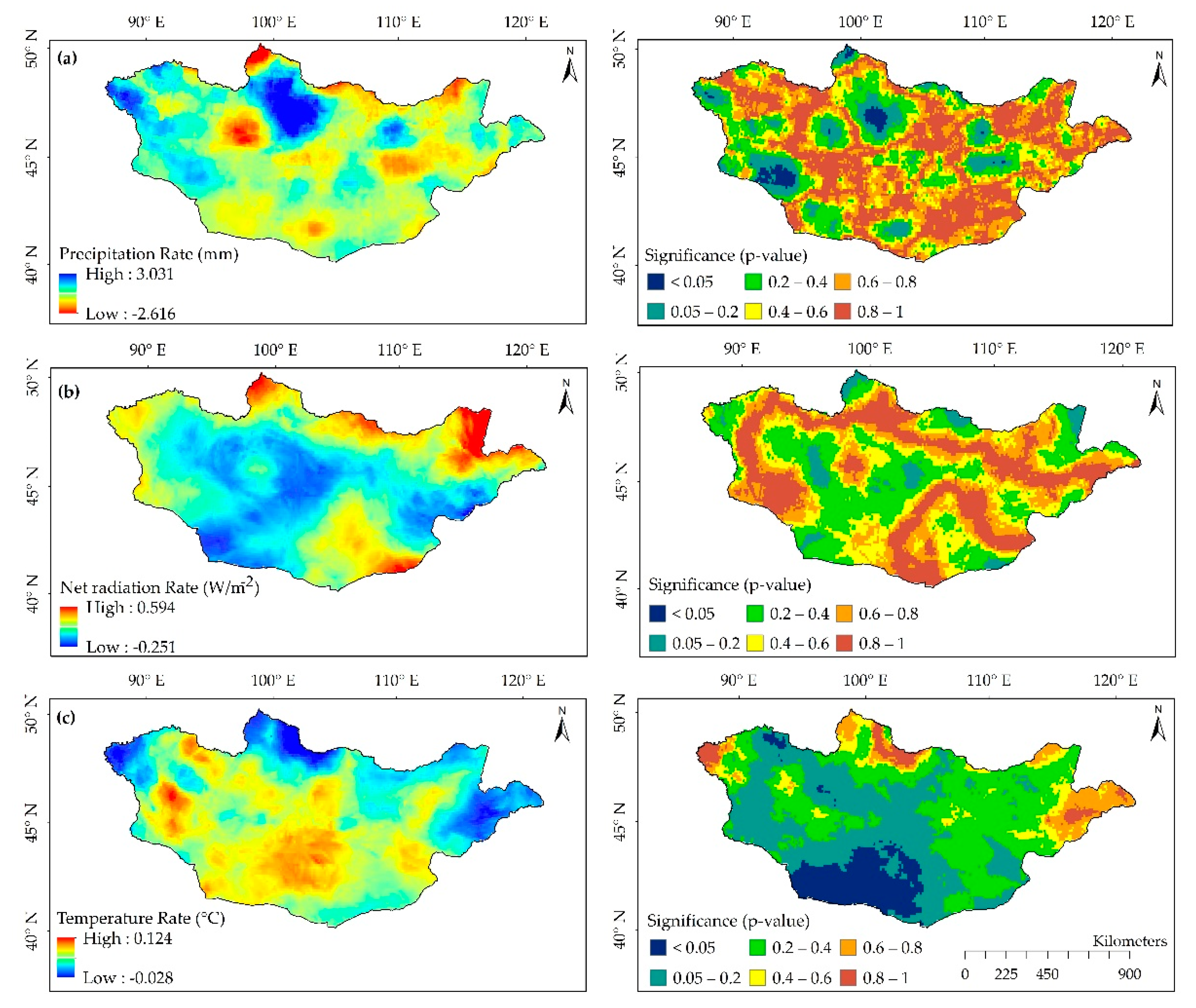
References
- Polley, H.W.; Bailey, D.W.; Nowak, R.S.; Stafford-Smith, M. Ecological Consequences of Climate Change on Rangelands. In Rangeland Systems Processes, Management and Challenges; Springer Series on Environmental Management; Springer: Cham, Swityerland, 2017; pp. 229–260. [Google Scholar]
- Reid, R.S.; Fernández-Giménez, M.E.; Galvin, K.A. Dynamics and Resilience of Rangelands and Pastoral Peoples Around the Globe. Ann. Rev. 2014, 39, 217–242. [Google Scholar] [CrossRef]
- Mccollum, D.W.; Tanaka, J.A.; Morgan, J.A.; Mitchell, J.E.; Fox, W.E.; Maczko, K.A.; Hidinger, L.; Duke, C.S.; Kreuter, U.P. Climate Change Effects on Rangelands and Rangeland Management: Affirming the Need for Monitoring. Ecosyst. Health Sustain. 2017, 3, e01264. [Google Scholar] [CrossRef] [Green Version]
- Angerer, J.; Han, G.; Fujisaki, I.; Havstad, K. Climate Change and Ecosystems of Asia With Emphasis on Inner Mongolia and Mongolia. Rangelands 2008, 30, 46–51. [Google Scholar] [CrossRef] [Green Version]
- Li, S.-G.; Asanuma, J.; Eugster, W.; Kotani, A.; Liu, J.-J.; Urano, T.; Oikawa, T.; Davaa, G.; Oyunbaatar, D.; Sugita, M. Net Ecosystem Carbon Dioxide Exchange over Grazed Steppe in Central Mongolia. Glob. Chang. Biol. 2005, 11, 1941–1955. [Google Scholar] [CrossRef]
- Hilker, T.; Natsagdorj, E.; Waring, R.H.; Lyapustin, A.; Wang, Y. Satellite Observed Widespread Decline in Mongolian Grasslands Largely Due to Overgrazing. Glob. Chang. Biol. 2014, 20, 418–428. [Google Scholar] [CrossRef] [Green Version]
- Liu, Y.Y.; Evans, J.P.; McCabe, M.F.; de Jeu, R.A.M.; van Dijk, A.I.J.M.; Dolman, A.J.; Saizen, I. Changing Climate and Overgrazing Are Decimating Mongolian Steppes. PLoS ONE 2013, 8, e57599. [Google Scholar] [CrossRef] [PubMed] [Green Version]
- Cheng, Y.; Tsubo, M.; Ito, T.Y.; Nishihara, E.; Shinoda, M. Impact of Rainfall Variability and Grazing Pressure on Plant Diversity in Mongolian Grasslands. J. Arid Environ. 2011, 75, 471–476. [Google Scholar] [CrossRef]
- Wesche, K.; Ronnenberg, K.; Retzer, V.; Miehe, G. Effects of Large Herbivore Exclusion on Southern Mongolian Desert Steppes. Acta Oecologica 2010, 36, 234–241. [Google Scholar] [CrossRef]
- Miao, L.; Fraser, R.; Sun, Z.; Sneath, D.; He, B.; Cui, X. Climate Impact on Vegetation and Animal Husbandry on the Mongolian Plateau: A Comparative Analysis. Nat. Hazards 2016, 80, 727–739. [Google Scholar] [CrossRef]
- Sankey, T.T.; Sankey, J.B.; Weber, K.T.; Montagne, C. Geospatial Assessment of Grazing Regime Shifts and Sociopolitical Changes in a Mongolian Rangeland. Rangel. Ecol. Manag. 2009, 62, 522–530. [Google Scholar] [CrossRef]
- Khishigbayar, J.; Fernández-Giménez, M.E.; Angerer, J.P.; Reid, R.S.; Chantsallkham, J.; Baasandorj, Y.; Zumberelmaa, D. Mongolian Rangelands at a Tipping Point? Biomass and Cover Are Stable but Composition Shifts and Richness Declines after 20 years of Grazing and Increasing Temperatures. J. Arid Environ. 2015, 115, 100–112. [Google Scholar] [CrossRef]
- Nandintsetseg, B.; Shinoda, M. Assessment of Drought Frequency, Duration, and Severity and Its Impact on Pasture Production in Mongolia. Nat. Hazards 2013, 66, 995–1008. [Google Scholar] [CrossRef]
- Bruegger, R.A.; Jigjsuren, O.; Fernández-Giménez, M.E. Herder Observations of Rangeland Change in Mongolia: Indicators, Causes, and Application to Community-Based Management. Rangel. Ecol. Manag. 2014, 67, 119–131. [Google Scholar] [CrossRef]
- Jambal, S.; Urianhai, N.G.; Otoda, T.; Yamada, Y.; Jamsran, U.; Sakamoto, K.; Yoshikawa, K. Effect of Grazing Pressure on the Structure of Rangeland Plant Community in Mongolia. J. Arid Land Stud. 2012, 22, 235–238. [Google Scholar]
- Chen, Y.; Lee, G.; Lee, P.; Oikawa, T. Model Analysis of Grazing Effect on Above-Ground Biomass and above-Ground Net Primary Production of a Mongolian Grassland Ecosystem. J. Hydrol. 2007, 333, 155–164. [Google Scholar] [CrossRef]
- Bao, G.; Bao, Y.; Sanjjava, A.; Qin, Z.; Zhou, Y.; Xu, G. NDVI-Indicated Long-Term Vegetation Dynamics in Mongolia and Their Response to Climate Change at Biome Scale. Int. J. Climatol. 2015, 35, 4293–4306. [Google Scholar] [CrossRef]
- Cowtan, K.; Way, R.G. Coverage Bias in the HadCRUT4 Temperature Series and Its Impact on Recent Temperature Trends. Q. J. R. Meteorol. Soc. 2014, 140, 1935–1944. [Google Scholar] [CrossRef] [Green Version]
- Eckstein, D.; Künzel, V.; Schäfer, L.; Winges, M. Global Climate Risk Index 2020 Who Suffers Most from Extreme Weather Events? Germanwatch: Bonn, Germany, 2020; ISBN 978-3-943704-77-8. [Google Scholar]
- Harmeling, S. Global Climate Risk Index 2010: Who Is the Most Vulnerable? Weather-Related Loss Events since 1990 and How Copenhagen Needs to Responds; Germanwatch: Bonn, Germany, 2010. [Google Scholar]
- UNDP Climate Change Adaptation. Mongolia Achieves a Milestone in National Adaptation Planning. 2019. Available online: https://www.adaptation-undp.org/ (accessed on 27 March 2021).
- Pfeiffer, M.; Dulamsuren, C.; Wesche, K. Grasslands and Shrublands of Mongolia; Elsevier Inc.: Amsterdam, The Netherlands, 2020; ISBN 9780124095489. [Google Scholar]
- Jun, W.; Daniel, G.B.; Jiquan, C. Drivers of the Dynamics in Net Primary Productivity across Ecological Zones on the Mongolian Plateau. Landsc. Ecol. 2013, 28, 725–739. [Google Scholar] [CrossRef]
- Nanzad, L.; Zhang, J.; Tuvdendorj, B.; Nabil, M.; Zhang, S.; Bai, Y. NDVI Anomaly for Drought Monitoring and Its Correlation with Climate Factors over Mongolia from 2000 to 2016. J. Arid Environ. 2019, 164, 69–77. [Google Scholar] [CrossRef]
- Dorjsuren, M.; Liou, Y.A.; Cheng, C.H. Time Series MODIS and in Situ Data Analysis for Mongolia Drought. Remote Sens. 2016, 8, 509. [Google Scholar] [CrossRef] [Green Version]
- Tong, S.; Lai, Q.; Zhang, J.; Bao, Y.; Lusi, A.; Ma, Q.; Li, X.; Zhang, F. Spatiotemporal Drought Variability on the Mongolian Plateau from 1980–2014 Based on the SPEI-PM, Intensity Analysis and Hurst Exponent. Sci. Total Environ. 2018, 615, 1557–1565. [Google Scholar] [CrossRef] [PubMed]
- Sternberg, T. Investigating the Presumed Causal Links between Drought and Dzud in Mongolia. Nat. Hazards 2018, 92, 27–43. [Google Scholar] [CrossRef] [Green Version]
- Otani, S.; Onishi, K.; Kurozawa, Y.; Kurosaki, Y.; Bat-Oyun, T.; Shinoda, M.; Mu, H. Assessment of the Effects of Severe Winter Disasters (Dzud) on Public Health in Mongolia on the Basis of Loss of Livestock. Disaster Med. Public Health Prep. 2016, 10, 549–552. [Google Scholar] [CrossRef] [PubMed]
- Liu, Z.; Yao, Z.; Huang, H.; Batjav, B.; Wang, R. Evaluation of Extreme Cold and Drought over the Mongolian Plateau. Water 2019, 11, 74. [Google Scholar] [CrossRef] [Green Version]
- Rao, M.P.; Davi, N.K.; D’Arrigo, R.D.; Skees, J.; Nachin, B.; Leland, C.; Lyon, B.; Wang, S.Y.; Byambasuren, O. Dzuds, Droughts, and Livestock Mortality in Mongolia. Environ. Res. Lett. 2015, 10, 074012. [Google Scholar] [CrossRef]
- United Nations. Environmental Performance Reviews (Mongolia Synopsis); United Nations: New York, NY, USA; Geneva, Switzerland, 2018. [Google Scholar]
- Al-bukhari, A.; Hallett, S.; Brewer, T. A Review of Potential Methods for Monitoring Rangeland Degradation in Libya. Pastoralism 2018, 8, 1–14. [Google Scholar] [CrossRef]
- Peng, D.; Zhang, B.; Wu, C.; Huete, A.R.; Gonsamo, A.; Lei, L.; Ponce-Campos, G.E.; Liu, X.; Wu, Y. Country-Level Net Primary Production Distribution and Response to Drought and Land Cover Change. Sci. Total Environ. 2017, 574, 65–77. [Google Scholar] [CrossRef] [PubMed]
- Liang, W.; Yang, Y.; Fan, D.; Guan, H.; Zhang, T.; Long, D.; Zhou, Y.; Bai, D. Analysis of Spatial and Temporal Patterns of Net Primary Production and Their Climate Controls in China from 1982 to 2010. Agric. For. Meteorol. 2015, 204, 22–36. [Google Scholar] [CrossRef]
- Shinoda, M.; Nachinshonhor, G.U.; Nemoto, M. Impact of Drought on Vegetation Dynamics of the Mongolian Steppe: A Field Experiment. J. Arid Environ. 2010, 74, 63–69. [Google Scholar] [CrossRef]
- Crabtree, R.; Potter, C.; Mullen, R.; Sheldon, J.; Huang, S.; Harmsen, J.; Rodman, A.; Jean, C. A Modeling and Spatio-Temporal Analysis Framework for Monitoring Environmental Change Using NPP as an Ecosystem Indicator. Remote Sens. Environ. 2009, 113, 1486–1496. [Google Scholar] [CrossRef] [Green Version]
- Cao, M.; Prince, S.D.; Small, J.; Goetz, S.J. Remotely Sensed Interannual Variations and Trends in Terrestrial Net Primary Productivity 1981–2000. Ecosystems 2004, 7, 233–242. [Google Scholar] [CrossRef]
- Fensholt, R.; Sandholt, I.; Schultz, M.; Stisen, S.; Diouf, A. Evaluation of Satellite Based Primary Production Modelling in the Semi-Arid Sahel. Remote Sens. Environ. 2006, 105, 173–188. [Google Scholar] [CrossRef]
- Raich, J.W.; Rastetter, E.B.; Melillo, J.M.; Kicklighter, D.W.; Steudler, P.A.; Grace, A.L.; More, B., III; Vörösmarty, C.J. Potential Net Primary Productivity in South America: Application of a Global Model. Ecol. Appl. 1991, 1, 399–429. [Google Scholar] [CrossRef] [PubMed] [Green Version]
- Melillo, J.M.; McGuire, A.D.; Kicklighter, D.W.; Moore, B.; Vorosmarty, C.J.; Schloss, A.L. Global Climate Change and Terrestrial Net Primary Production. Nature 1993, 363, 234–240. [Google Scholar] [CrossRef]
- Parton, W.J.; Scurlock, J.M.O.; Ojima, D.S.; Gilmanov, T.G.; Scholes, R.J.; Schimel, D.S.; Kirchner, T.; Menaut, J.-C.; Seastedt, T.; Garcia Moya, E.; et al. Observations and Modeling of Biomass and Soil Organic Matter Dynamics for the Grassland Biome Worldwide. Glob. Biogeochem. Cycles 1993, 7, 785–809. [Google Scholar] [CrossRef] [Green Version]
- Potter, S.; Randerson, T.; Field, B.; Matson, A.; Mooney, H.A. Terrestrial Ecosystem Production: A Process Model Based on Global Satellite and Surface Data. Glob. Biogeochem. Cycles 1993, 7, 811–841. [Google Scholar] [CrossRef]
- Running, S.W.; Hunt, E.R. Generalization of a forest ecosystem process model for other biomes, BIOME-BGC, and an application for global-scale models. In Scaling Physiological Processes: Leaf to Globe; Ehleringer, J.R., Field, C.B., Eds.; Academic Press: San Diego, CA, USA, 1993; pp. 141–158. [Google Scholar]
- Haxeltine, A.; Prentice, I.C. A General Model for the Light-Use Efficiency of Primary Production. Funct. Ecol. 1996, 10, 551. [Google Scholar] [CrossRef]
- Hazarika, M.K.; Yasuoka, Y.; Ito, A.; Dye, D. Estimation of Net Primary Productivity by Integrating Remote Sensing Data with an Ecosystem Model. Remote Sens. Environ. 2005, 94, 298–310. [Google Scholar] [CrossRef]
- Prince, S.D.; Goward, S.N. Global Primary Production: A Remote Sensing Approach. J. Biogeogr. 2006, 22, 815. [Google Scholar] [CrossRef]
- Bao, G.; Tuya, A.; Bayarsaikhan, S.; Dorjsuren, A.; Mandakh, U.; Bao, Y.; Li, C.; Vanchindorj, B. Variations and Climate Constraints of Terrestrial Net Primary Productivity over Mongolia. Quat. Int. 2020, 537, 112–125. [Google Scholar] [CrossRef]
- Bat-oyun, T.; Shinoda, M.; Tsubo, M. Estimation of Pasture Productivity in Mongolian Grasslands: Field Survey and Model Simulation. J. Agric. Meteorol. 2010, 66, 31–39. [Google Scholar] [CrossRef] [Green Version]
- Lin, C.; Dugarsuren, N. Deriving the Spatiotemporal NPP Pattern in Terrestrial Ecosystems of Mongolia Using MODIS Imagery. Photogramm. Eng. Remote Sens. 2015, 81, 587–598. [Google Scholar] [CrossRef]
- Matsushita, B.; Tamura, M. Integrating Remotely Sensed Data with an Ecosystem Model to Estimate Net Primary Productivity in East Asia. Remote Sens. Environ. 2002, 81, 58–66. [Google Scholar] [CrossRef]
- Chen, J.M.; Liu, J.; Cihlar, J.; Goulden, M.L. Daily Canopy Photosynthesis Model through Temporal and Spatial Scaling for Remote Sensing Applications. Ecol. Model. 1999, 124, 99–119. [Google Scholar] [CrossRef] [Green Version]
- Zhou, W.; Li, J.; Yue, T. Remote Sensing Monitoring and Evaluation of Degraded Grassland in China Accounting of Grassland Carbon Source and Carbon Sink; Springer Nature: Basingstoke, UK, 2020; ISBN 9789813293816. [Google Scholar]
- Chen, J.M.; Mo, G.; Pisek, J.; Liu, J.; Deng, F.; Ishizawa, M.; Chan, D. Effects of Foliage Clumping on the Estimation of Global Terrestrial Gross Primary Productivity. Glob. Biogeochem. Cycles 2012, 26, GB1019. [Google Scholar] [CrossRef]
- Feng, X.; Liu, G.; Chen, J.M.; Chen, M.; Liu, J.; Ju, W.M.; Sun, R.; Zhou, W. Net Primary Productivity of China’s Terrestrial Ecosystems from a Process Model Driven by Remote Sensing. J. Environ. Manag. 2007, 85, 563–573. [Google Scholar] [CrossRef] [PubMed]
- Liu, J.; Chen, J.M.; Cihlar, J.; Chen, W. Net Primary Productivity Distribution in the BOREAS Region from a Process Model Using Satellite and Surface Data the Model Results, the Following Statistics Were Obtained for (Excluding Burnt Areas in the Re _• on t Equal to g C m NPP for the SSA c = V. J. Geophys. Res. 1999, 104, 27735–27754. [Google Scholar] [CrossRef]
- Wang, Q.; Tenhunen, J.; Falge, E.; Bernhofer, C.; Granier, A.; Vesala, T. Simulation and Scaling of Temporal Variation in Gross Primary Production for Coniferous and Deciduous Temperate Forests. Glob. Chang. Biol. 2004, 10, 37–51. [Google Scholar] [CrossRef]
- Zhang, F.; Chen, J.M.; Chen, J.; Gough, C.M.; Martin, T.A.; Dragoni, D. Evaluating Spatial and Temporal Patterns of MODIS GPP over the Conterminous U.S. against Flux Measurements and a Process Model. Remote Sens. Environ. 2012, 124, 717–729. [Google Scholar] [CrossRef]
- Chen, Y.; Li, J.; Ju, W.; Ruan, H.; Qin, Z.; Huang, Y.; Jeelani, N.; Padarian, J.; Propastin, P. Quantitative Assessments of Water-Use Efficiency in Temperate Eurasian Steppe along an Aridity Gradient. PLoS ONE 2017, 12, e0179875. [Google Scholar] [CrossRef] [Green Version]
- Chen, Y.; Ju, W.; Mu, S.; Fei, X.; Cheng, Y.; Propastin, P.; Zhou, W.; Liao, C.; Chen, L.; Tang, R.; et al. Explicit Representation of Grazing Activity in a Diagnostic Terrestrial Model: A Data-Process Combined Scheme. J. Adv. Modeling Earth Syst. 2019, 11, 957–978. [Google Scholar] [CrossRef] [Green Version]
- Gomboluudev, P.; Natsagdorj, L. The Impact of Desertification on Mongolian Climate and Its Numerical Study Using Regional Climate Model (RegCM3). In Proceedings of the 3rd International Workshop on Terrestrial Change in Mongolia, Tsukuba, Japan, 9–10 November 2004; pp. 112–113. [Google Scholar]
- Nandintsetseg, B.; Greene, J.S.; Goulden, C.E. Trends in Extreme Daily Precipitation and Temperature near Lake Hövsgöl, Mongolia. Int. J. Climatol. 2007, 27, 341–347. [Google Scholar] [CrossRef]
- Batima, P.; Natsagdorj, L.; Gombluudev, P.; Erdenetsetseg, B. Observed Climate Change in Mongolia. AIACC Work. Pap. 2005, 12, 1–26. [Google Scholar]
- Mandakh, N.; Tsogtbaatar, J.; Dash, D.; Khudulmur, S. Spatial Assessment of Soil Wind Erosion Using WEQ Approach in Mongolia. J. Geogr. Sci. 2016, 26, 473–483. [Google Scholar] [CrossRef] [Green Version]
- Chen, B.; Coops, N.C. Understanding of Coupled Terrestrial Carbon, Nitrogen and Water Dynamics—An Overview. Sensors 2009, 9, 8624–8657. [Google Scholar]
- Liu, J.; Chen, J.M.; Cihlar, J.; Park, W.M. A Process-Based Boreal Ecosystem Productivity Simulator Using Remote Sensing Inputs. Remote Sens. Environ. 1997, 62, 158–175. [Google Scholar] [CrossRef]
- Liu, J.; Chen, J.M.; Cihlar, J.; Chen, W. Net Primary Productivity Mapped for Canada at 1-Km Resolution. Glob. Ecol. Biogeogr. 2002, 11, 115–129. [Google Scholar] [CrossRef] [Green Version]
- Ryan, M.G. A Simple Method for Estimating Gross Carbon Budgets for Vegetation in Forest Ecosystems. Tree Physiol. 1991, 9, 255–266. [Google Scholar] [CrossRef] [PubMed]
- Ryan, M.G.; Lavigne, M.B.; Gower, S.T. Annual Carbon Cost of Autotrophic Respiration in Boreal Forest Ecosystems in Relation to Species and Climate. J. Geophys. Res. Atmos. 1997, 102, 28871–28883. [Google Scholar] [CrossRef] [Green Version]
- Mann, H.B. Nonparametric Tests against Trend. Econom. J. Econom. Soc. 1945, 13, 245–259. [Google Scholar] [CrossRef]
- Sen, P.K. Estimates of the Regression Coefficient Based on Kendall’s Tau. J. Am. Stat. Assoc. 1968, 63, 1379–1389. [Google Scholar] [CrossRef]
- Baniya, B.; Tang, Q.; Xu, X.; Haile, G.; Chhipi-Shrestha, G. Spatial and Temporal Variation of Drought Based on Satellite Derived Vegetation Condition Index in Nepal from 1982–2015. Sensors 2019, 19, 430. [Google Scholar] [CrossRef] [Green Version]
- Tong, S.; Zhang, J.; Bao, Y.; Terigele, W.; Weilisi, L. Spatial and Temporal Variations of Vegetation Cover and the Relationships with Climate Factors in Inner Mongolia Based on GIMMS NDVI3g Data. J. Arid Land 2017, 9, 394–407. [Google Scholar] [CrossRef] [Green Version]
- Pangali Sharma, T.P.; Zhang, J.; Khanal, N.R.; Prodhan, F.A.; Paudel, B.; Shi, L.; Nepal, N. Assimilation of Snowmelt Runoff Model (SRM) Using Satellite Remote Sensing Data in Budhi Gandaki River Basin, Nepal. Remote Sens. 2020, 12, 1951. [Google Scholar] [CrossRef]
- Koju, U.A.; Zhang, J.; Maharjan, S.; Bai, Y.; Zhang, S.; Yao, F. Analysis of Spatiotemporal Dynamics of Forest Net Primary Productivity of Nepal during 2000–2015. Int. J. Remote Sens. 2020, 41, 4336–4364. [Google Scholar] [CrossRef]
- Dimiceli, C.; Carroll, M.; Sohlberg, R.; Kim, D.H.; Kelly, M.; Townshend, J.R.G. MOD44B MODIS/Terra Vegetation Continuous Fields Yearly L3 Global 250m SIN Grid V006. NASA EOSDIS Land Processes DAAC 2015. [Google Scholar] [CrossRef]
- Liang, L.; Liu, Q.; Liu, G.; Li, H.; Huang, C. Accuracy Evaluation and Consistency Analysis of Four Global Land Cover Products in the Arctic Region. Remote Sens. 2019, 11, 1396. [Google Scholar] [CrossRef] [Green Version]
- Pyankov, V.I.; Gunin, P.D.; Tsoog, S.; Black, C.C. C 4 Plants in the Vegetation of Mongolia: Their Natural Occurrence and Geographical Distribution in Relation to Climate. Oecologia 2000, 123, 15–31. [Google Scholar] [CrossRef]
- Running, S.; Zhao, M. MODIS/Terra Net Primary Production Gap-Filled Yearly L4 Global 500m SIN Grid V006. 2019. Available online: https://lpdaac.usgs.gov/news/release-modis-version-6-net-evapotranspiration-gpp-and-npp-gap-filled-products/ (accessed on 27 March 2021).
- Li, P.; Peng, C.; Wang, M.; Li, W.; Zhao, P.; Wang, K.; Yang, Y.; Zhu, Q. Quantification of the Response of Global Terrestrial Net Primary Production to Multifactor Global Change. Ecol. Indic. 2017, 76, 245–255. [Google Scholar] [CrossRef]
- Nemani, R.R.; Keeling, C.D.; Hashimoto, H.; Jolly, W.M.; Piper, S.C.; Tucker, C.J.; Myneni, R.B.; Running, S.W. Climate-Driven Increases in Global Terrestrial Net Primary Production from 1982 to 1999. Science 2003, 300, 1560–1563. [Google Scholar] [CrossRef] [PubMed] [Green Version]
- Li, Z.; Chen, Y.; Wang, Y.; Fang, G. Dynamic Changes in Terrestrial Net Primary Production and Their Effects on Evapotranspiration. Hydrol. Earth Syst. Sci. 2016, 20, 2169–2178. [Google Scholar] [CrossRef] [Green Version]
- Wang, J.; Wei, H.; Cheng, K.; Ochir, A.; Davaasuren, D.; Li, P.; Shun Chan, F.K.; Nasanbat, E. Spatio-Temporal Pattern of Land Degradation from 1990 to 2015 in Mongolia. Environ. Dev. 2020, 34, 100497. [Google Scholar] [CrossRef]
- Bao, G.; Chen, J.; Chopping, M.; Bao, Y.; Bayarsaikhan, S.; Dorjsuren, A.; Tuya, A.; Jirigala, B.; Qin, Z. Dynamics of Net Primary Productivity on the Mongolian Plateau: Joint Regulations of Phenology and Drought. Int. J. Appl. Earth Obs. Geoinf. 2019, 81, 85–97. [Google Scholar] [CrossRef]
- Liu, Y.; Xiao, J.; Ju, W.; Zhou, Y.; Wang, S.; Wu, X. Water Use Efficiency of China’s Terrestrial Ecosystems and Responses to Drought. Sci. Rep. 2015, 5, 1–12. [Google Scholar] [CrossRef]
- Sun, B.; Zhao, H.; Wang, X. Effects of Drought on Net Primary Productivity: Roles of Temperature, Drought Intensity, and Duration. Chin. Geogr. Sci. 2016, 26, 270–282. [Google Scholar] [CrossRef] [Green Version]
- Pei, F.; Li, X.; Liu, X.; Lao, C. Assessing the Impacts of Droughts on Net Primary Productivity in China. J. Environ. Manag. 2013, 114, 362–371. [Google Scholar] [CrossRef]
- Nandintsetseg, B.; Boldgiv, B.; Chang, J.; Ciais, P.; Enkhbaatar, D.; Altangerel, B.; Tserenpurev, B.-O.; Stenseth, N.C. Risk and Vulnerability of Mongolian Grasslands under Climate Change. Environ. Res. Lett. 2021, 16, 034035. [Google Scholar] [CrossRef]
- Yang, J.; Zhang, X.C.; Luo, Z.H.; Yu, X.J. Nonlinear Variations of Net Primary Productivity and Its Relationship with Climate and Vegetation Phenology, China. Forests 2017, 8, 361. [Google Scholar] [CrossRef] [Green Version]
- Nakano, T.; Bat-Oyun, T.; Shinoda, M. Responses of Palatable Plants to Climate and Grazing in Semi-Arid Grasslands of Mongolia. Glob. Ecol. Conserv. 2020, 24, e01231. [Google Scholar] [CrossRef]


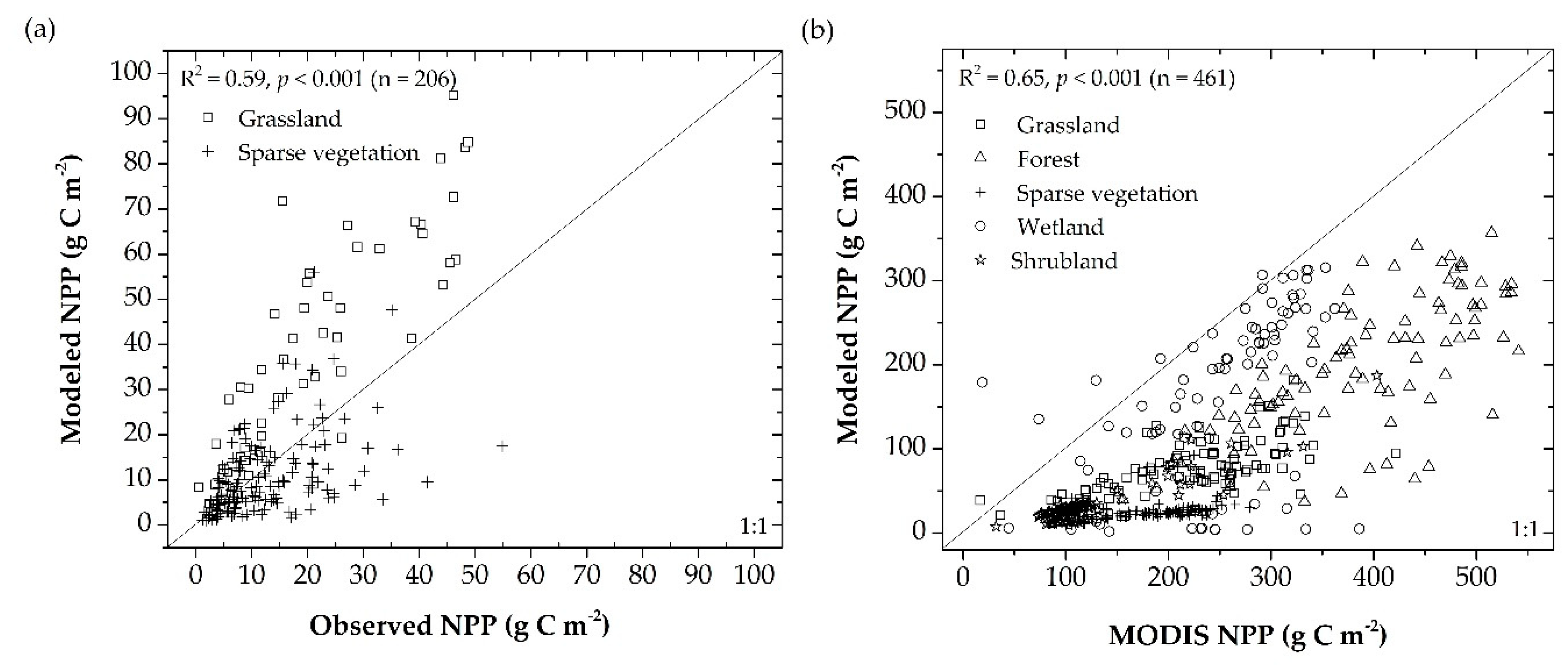

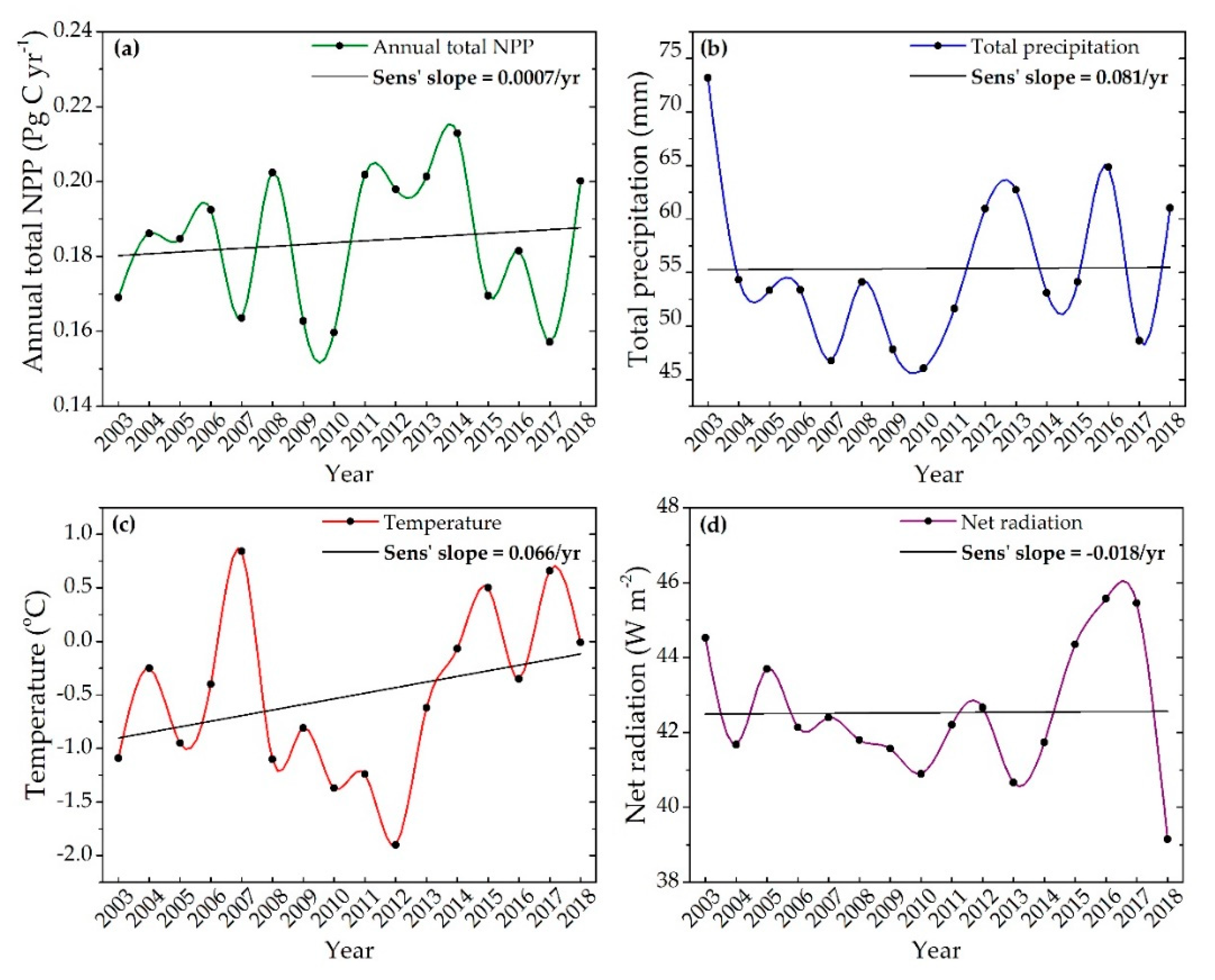
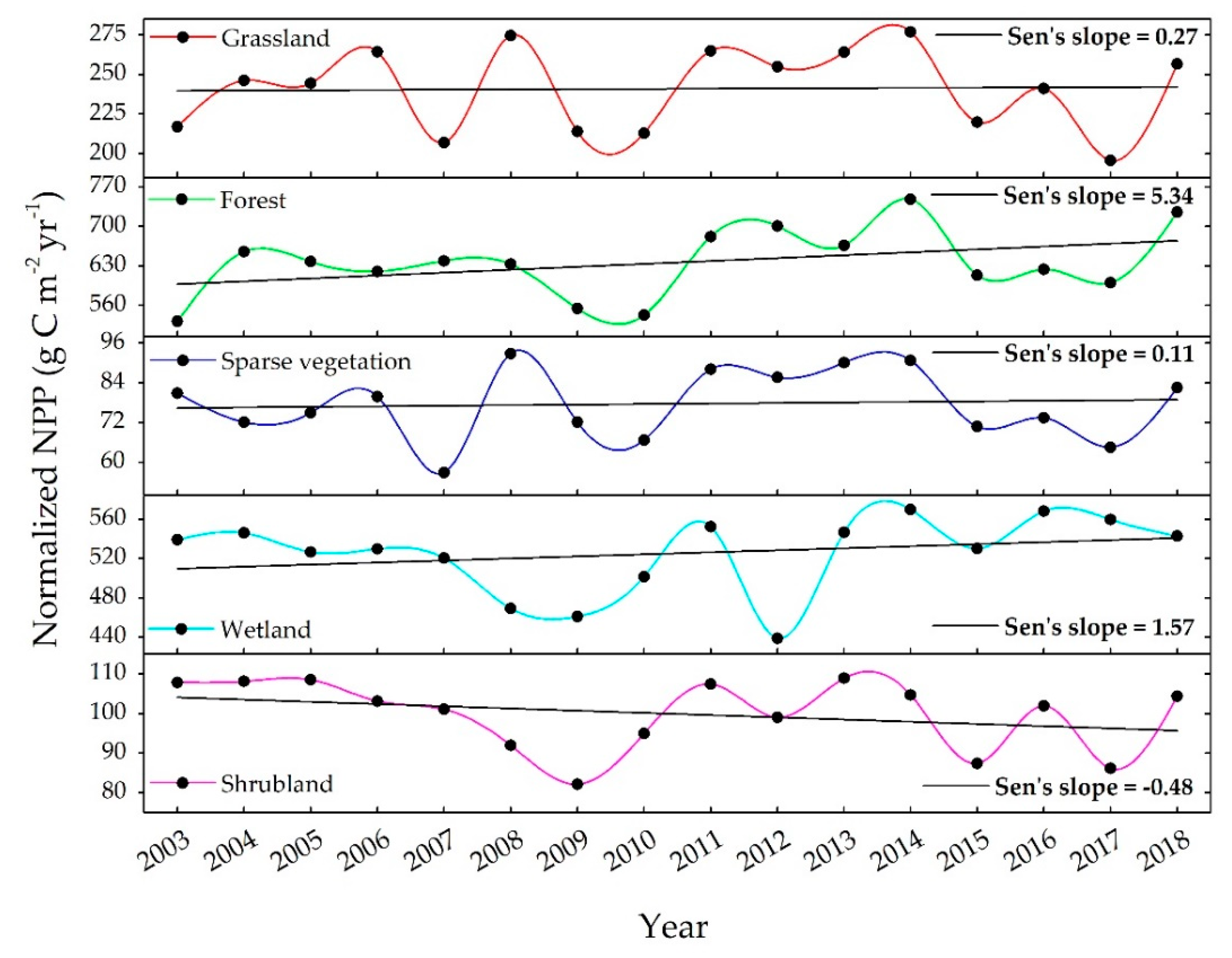
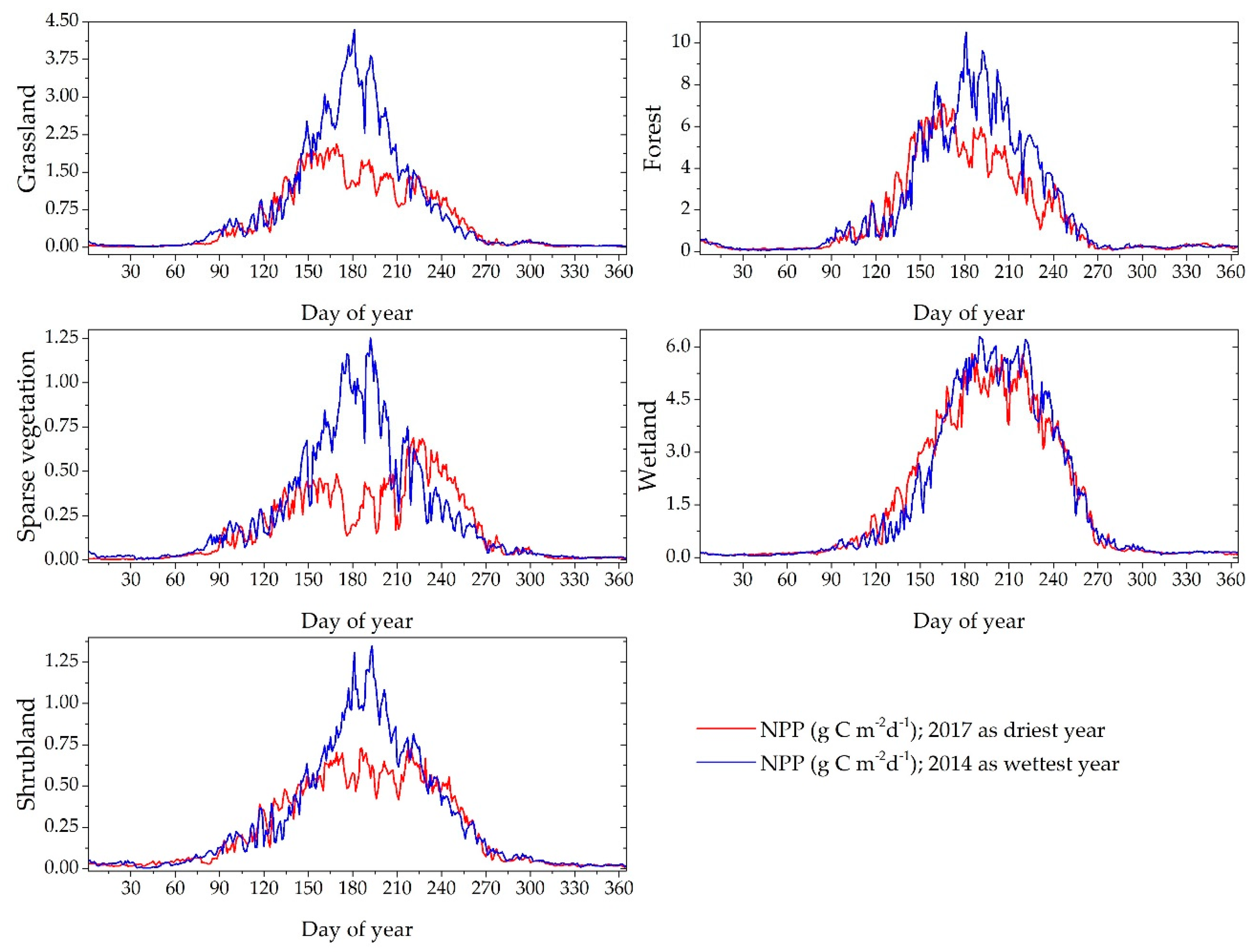
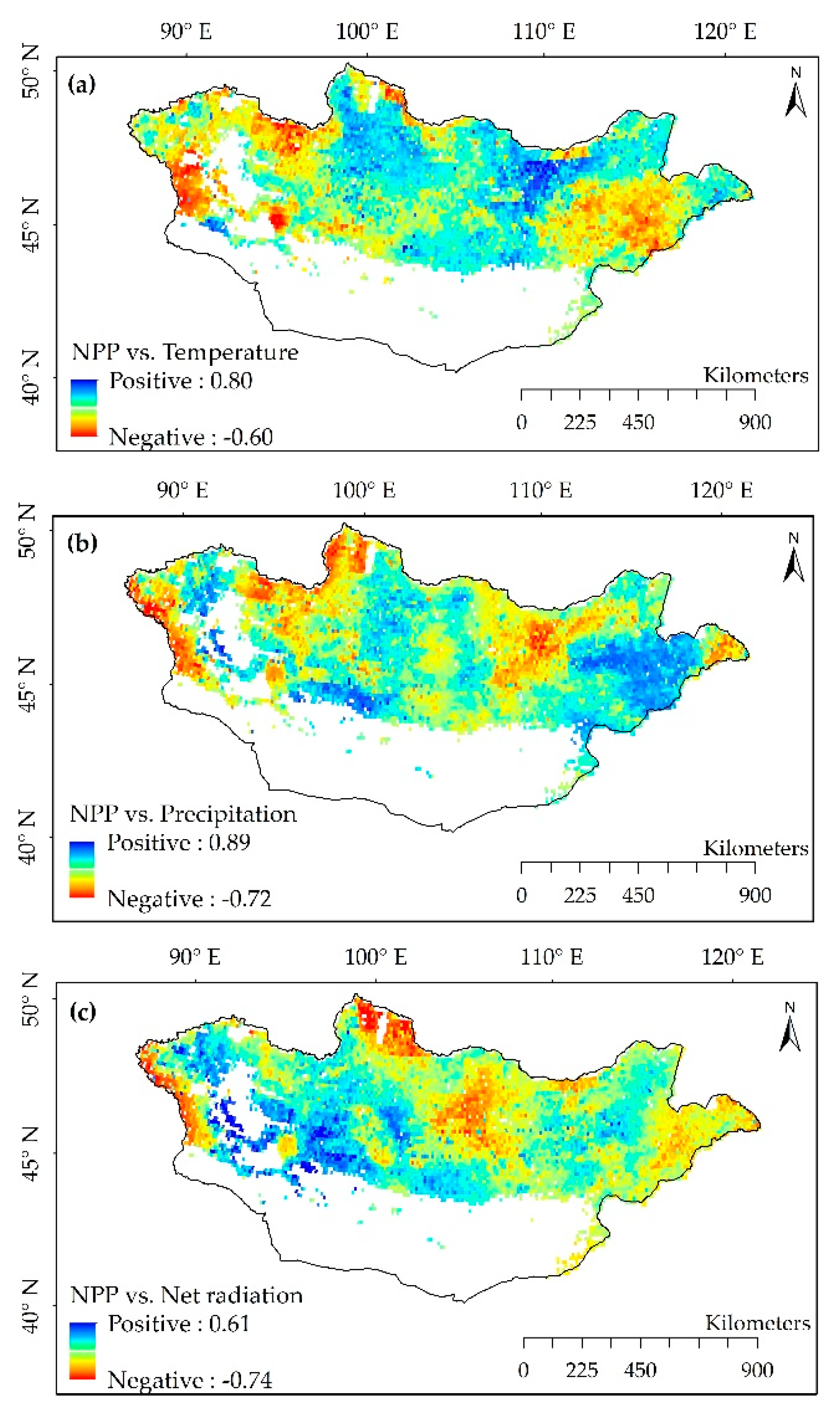
| CCI-LC | Code | Target Legend (Boreal Ecosystem Productivity Simulator) | Code | Target Legend (Veg. Analysis) |
|---|---|---|---|---|
| Broadleaf deciduous closed to open (>15%) | 60 | Needleleaf evergreen forest | 1 | Forest |
| Broadleaf deciduous closed (>40%) | 61 | |||
| Broadleaf deciduous open (15–40%) | 62 | Broadleaf evergreen forest | 2 | |
| Needleleaf evergreen closed to open (>15%) | 70 | |||
| Needleleaf evergreen closed (>40%) | 71 | Needleleaf deciduous forest | 3 | |
| Needleleaf evergreen open (15–40%) | 72 | |||
| Needleleaf deciduous closed to open (>15%) | 80 | Broadleaf deciduous forest | 4 | |
| Mixed leaf type | 90 | |||
| Mosaic tree and shrub (>50%) | 100 | Mixed forest | 5 | |
| Wetland tree | 160 | |||
| Shrubland | 120 | Closed shrublands | 6 | Shrubland |
| Shrubland evergreen | 121 | |||
| Shrubland deciduous | 122 | Open shrublands | 7 | |
| Mosaic herbaceous cover (>50%) | 110 | Woody savannas | 8 | Grassland |
| Grassland | 130 | Savannas | 9 | |
| Grasslands | 10 | |||
| Wetland shrub or herbaceous | 180 | Permanent wetland | 11 | Wetland |
| Cropland | 10 | Cropland | 12 | Cropland |
| Herbaceous cover | 11 | |||
| Mosaic cropland (>50%)/natural vegetation | 30 | |||
| Mosaic natural vegetation | 40 | Cropland/vegetation mosaic | 14 | |
| Urban areas | 190 | Urban | 13 | Urban |
| Permanent snow and ice | 220 | Snow/ice | 15 | Snow/ice |
| Lichens and mosses | 140 | Sparse vegetation | 16 | Sparse vegetation |
| Sparse vegetation (<15%) | 150 | |||
| Sparse shrub (<15%) | 152 | |||
| Sparse herbaceous cover (<15%) | 153 | |||
| Bare areas | 200 | Bare areas | 17 | Barren land |
| Consolidated bare areas | 201 | |||
| Unconsolidated bare areas | 202 | |||
| Water bodies | 210 | Water bodies | 0 | Water bodies |
| Vegetation Types | Mean Annual NPP (g C m−2 year−1) | Annual Total NPP (Pg C) | Percentage of Area (%) | Percentage of NPP (%) |
|---|---|---|---|---|
| Grassland | 77.72 | 0.07693 | 41.74 | 48.05 |
| Forest | 195.23 | 0.05268 | 10.83 | 32.4 |
| Sparse vegetation | 25.27 | 0.02717 | 45.76 | 16.98 |
| Wetland | 167.28 | 0.00201 | 0.5 | 2.03 |
| Shrubland | 32.75 | 0.00089 | 1.17 | 0.54 |
| Climatic Parameters | Grassland | Forest | Wetland | Sparse Vegetation | Shrubland |
|---|---|---|---|---|---|
| Temperature | 0.884 | 0.913 | 0.929 | 0.951 | 0.951 |
| Precipitation | 0.747 | 0.592 | 0.529 | 0.725 | 0.634 |
| Net Radiation | 0.769 | 0.747 | 0.348 | 0.594 | 0.494 |
Publisher’s Note: MDPI stays neutral with regard to jurisdictional claims in published maps and institutional affiliations. |
© 2021 by the authors. Licensee MDPI, Basel, Switzerland. This article is an open access article distributed under the terms and conditions of the Creative Commons Attribution (CC BY) license (http://creativecommons.org/licenses/by/4.0/).
Share and Cite
Nanzad, L.; Zhang, J.; Batdelger, G.; Pangali Sharma, T.P.; Koju, U.A.; Wang, J.; Nabil, M. Analyzing NPP Response of Different Rangeland Types to Climatic Parameters over Mongolia. Agronomy 2021, 11, 647. https://doi.org/10.3390/agronomy11040647
Nanzad L, Zhang J, Batdelger G, Pangali Sharma TP, Koju UA, Wang J, Nabil M. Analyzing NPP Response of Different Rangeland Types to Climatic Parameters over Mongolia. Agronomy. 2021; 11(4):647. https://doi.org/10.3390/agronomy11040647
Chicago/Turabian StyleNanzad, Lkhagvadorj, Jiahua Zhang, Gantsetseg Batdelger, Til Prasad Pangali Sharma, Upama Ashish Koju, Jingwen Wang, and Mohsen Nabil. 2021. "Analyzing NPP Response of Different Rangeland Types to Climatic Parameters over Mongolia" Agronomy 11, no. 4: 647. https://doi.org/10.3390/agronomy11040647








